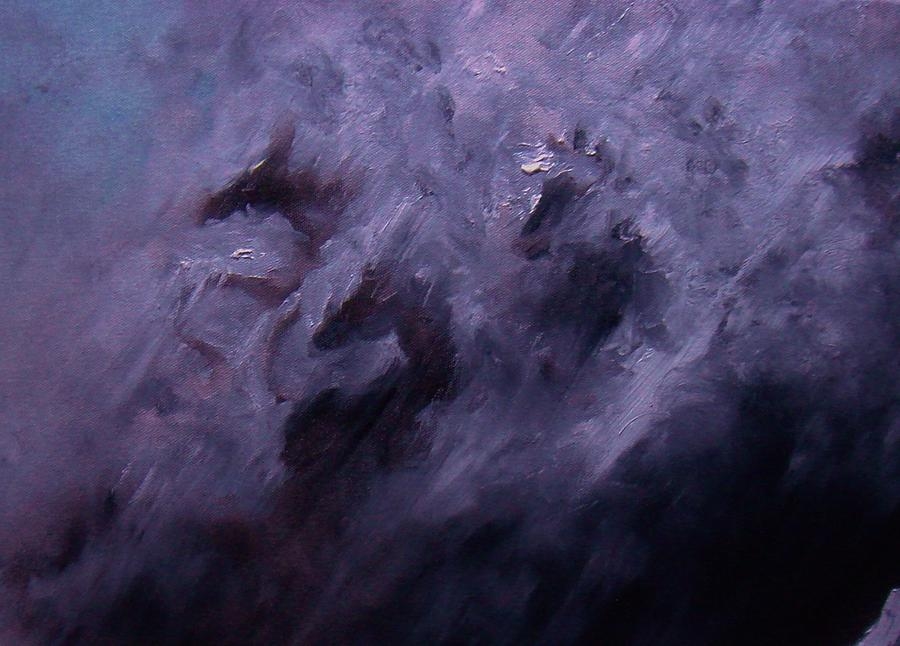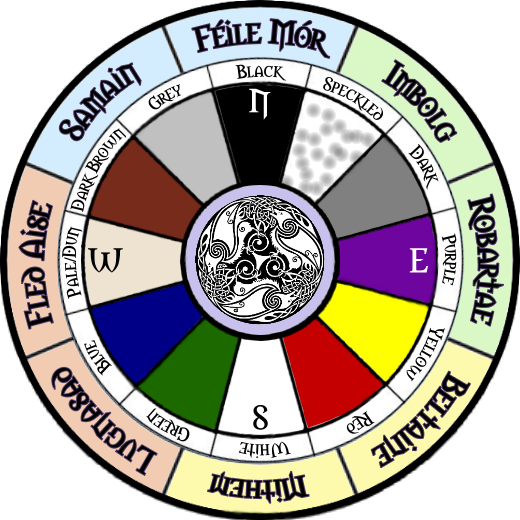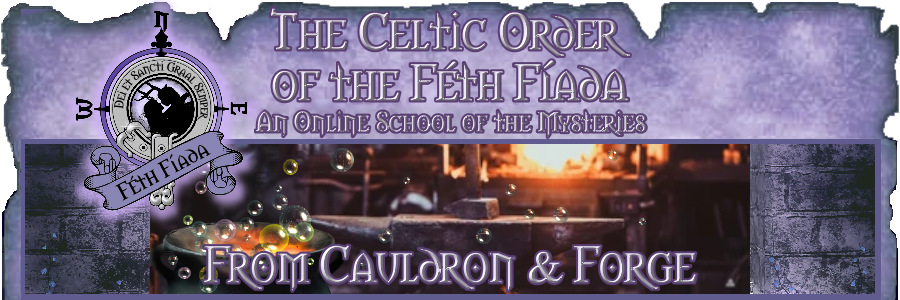
Who has seen the wind?
Neither I nor you:
But when the leaves hang trembling,
The wind is passing through.
Who has seen the wind?
Neither you nor I:
But when the trees bow down their heads,
The wind is passing by.
~ Nursery Rhyme written by Christina Rossetti, circa 1872.
The skies are already darkening; the wind is indeed beginning to rise; and I know that if the storms come, so, too, will the Gathan-Dubha, the Storm Riders — “the dark undulations seen in falling rain, when gusts of wind compress and scatter the rain like the waves of the sea….Cho luath ris na gathan-dubha, as swift as the storm-riders; cho lìonmhor ris na gathan-dubha, as numerous as the black darts.”[1]
I have worked with the Gathan-Dubha for many long years now, and once in a ritual, I described them thusly:
Suddenly, there comes such a horrific sound that it is almost deafening. It is the rasp and rush of a horde of howling and snarling winds surging tumultuously across the night sky. These are the grim, foreboding Gathan-Dubha — the wild Storm Riders, the great, primeval beings who have been the Lords of the Twelve Winds of Color since the very beginning of Time.There are other winds, too, of which the Gathan-Dubha are masters — but none so harsh and unforgiving as the winds of the Dark or Winter Half of the Year, particularly the northern winds.Without warning, before you realize what they intend, they swoop down — unbelievably powerful, dark, amorphous entities, endlessly shifting in both face and form, mouths bellowing and spewing air — hurtling over the land to seize hold of you and carry you away, bearing you aloft upon the unfettered, untamed winds they so boldly ride.
You gasp for breath, feeling it snatched away by the altitude and the icy winds. Your hair whips wildly, and your heart pounds. You’re utterly terrified that you’re going to fall. But the Storm Rider who holds you so tightly has enfolded you securely in his long, streaming cloak; and after a moment, instead of fear, you feel power and exhilaration begin to course like a jolting electric current through your body.
In the distance, brilliant lightning shatters the night sky; thunder rumbles and roils as up the Spirit Road to the midnight lands of the North, you ride. From here blows the Black Wind, blustering and moaning, accompanied by the hateful, harsh Grey Wind and the Speckled Wind, full of hard rain and sleet. These are cold, biting winds that flay the very body and soul….

Here at COFF, we study the Element Air and create our Book of Winds in the Third Degree. But long before then, we start getting to know the Twelve Winds of Color and the Gathan-Dubha, all of which appear to be unique to Ireland. We find revelations about them in the tenth-century Saltair na Rann (Psalter of the Staves or Quatrains), in the Senchas Már or Senchus Mor (the Great Tradition), and in the Hibernica Minor (Being a Fragment of an Old Irish Treatise on the Psalter).
The Saltair na Rann tells us that:
King who ordained the eight winds
advancing without uncertainty, full of beauty,
the four prime winds He holds back,
the four fierce under-winds.
There are four other under-winds,
as learned authors say,
this should be the number, without any error,
of the winds, twelve winds.
King who fashioned the colours of the winds,
who fixed them in safe courses,
after their manner, in well-ordered disposition,
with the varieties of each manifold hue.
The white, the clear purple,
the blue, the very strong green,
the yellow, the red, sure the knowledge,
in their gentle meetings wrath did not seize them.
The black, the grey, the speckled,
the dark and the deep brown,
the dun, darksome hues,
they are not light, easily controlled.
King who ordained them over every void,
the eight wild under-winds;
who laid down without defect
the bounds of the four prime winds.
From the East, the smiling purple,
from the South, the pure white, wondrous,
from the North, the black blustering moaning wind,
from the West, the babbling dun breeze.
The red, and the yellow along with it,
both white and purple;
the green, the blue, it is brave,
both dun and the pure white.
The grey, the dark brown, hateful their harshness,
both dun and deep black;
the dark, the speckled easterly wind
both black and purple.
Rightly ordered their form,
their disposition was ordained;
with wise adjustments, openly,
according to their position and their fixed places.[2]
A slightly different translation of the last several lines gives us:
The bright pure purple (corcra) from the east,
the bright wonderful white (gel) from the south,
the stormy harsh(?) Black (dub) from the north,
the noisy dun (odur) from the west.The red (derg) and yellow (buide) together
between white and purple;
the green (uaine), and the sea’s valiant blue (glas),
between dun and shining white.The grey (liath) and jet (ciar), terrible their ardour (?),
Between dun and jet-black;
the dark (temen) and the piebald (alad), in the east,
between black and purple.[3]
A like system of the Twelve Winds of Color is detailed in the Senchas Már, the earliest parts of which appear to date to the mid-5th century, pre-dating the arrival of St. Patrick in Ireland. While the dating of those particular paragraphs describing the winds isn’t at once obvious, they do seem to draw from the same source:
[God] also formed the eight winds — i.e., four chief winds, and four subordinate winds; and four other subordinate winds are mentioned, so that there are twelve winds accordingly. ¶ He also formed the colours of the winds, so that the colours of all these winds are different from each other — i.e., white and purple, pale gray and green, yellow and red, black and gray, speckled and the dark, the dark-brown, and the pale. From the east blows the purple wind, from the south the white, from the north the black, from the west the pale; the red and the yellow are between the white wind and the purple; the green and the pale gray are between the pale and the pure white; the gray and the dark-brown are between the pale and the jet black; the dark and speckled are between the black and the purple. And thus there are two subordinate winds between each chief wind.[4]
The Hibernica Minor names eight of the winds and provides us with some information about their inherent nature and effects:
Solanus [from the east] of a hundred battles,
It is fruitful though productive of plague;
It rejects (?) chiefs only.
Many are its diseases.Africus from the south-east, not bad.
It signifies specially good fruit,
Fish and corn, while it lasts.
It is unique in its excellences.As for Saronicus from the south,
It signifies to you a rich harvest,
A great quantity of full fruit,
Marvellous huge fish.Goods will be destroyed, a track not narrow,
If it is Favonius from the south-west:
It signifies every corn crop laid low,
Battles and scant harvests.It denotes the death of a king(s) if from the west.
It is P. around the ocean,
Great bloodshed, and slaying of men,
And plague on sinners.Pessima from the north-west only,
Dearth and slaughters,
And fall of blossoms it says,
Without . . . . . . .If it is F. from the north,
There will be noise of red-sworded battle,
Death of the sinful, plague and heat,
Drought and heavy distress.A fair multitude of fish, petty commemoration!
If it is Altanus from the north-east,
Sicknesses in it, battle with venom;
Many fruits it brings to us.[5]
Ronald Black and Alexander Carmichael in The Gaelic Otherworld and the Carmina Gadelica, respectively, record other attributes for the winds.
Even as they still do today for modern people, the winds played an important part in the lives of the ancient Celts. Winds could help sailors cross the seas to fish or trade, or they could bring storms that sunk ships or dashed them to pieces against rocky shores. Winds could help winnow seeds from chaff or flatten crops and orchards before they were harvested. Winds could freshen roundhouses or destroy them. They could keep cook fires flaming steadily or cause wildfires to burn completely out of control.
All this is one of the reasons why it pays to make friends with the Gathan-Dubha and to learn to paint with all the colors of the winds.
Blessings!
APs Rhianwen Bendigaid
Footnotes:
[1] “gath-dubh.” Am Faclair Beag. Faclair.com. Web. 26 February 2023.
[2] “Creation of the Winds with Their Colors, from Saltair na Rann” (Psalter of Staves or Quatrains). The Poem-Book of the Gael: Translations from Irish Gaelic Poetry into English Prose and Verse, Hull, Eleanor (Ed.). Chatto & Windus, 1913.
[3] Text in Saltair na Rann, ed. W. Stokes, Oxford, 1883, lines 69-80; translation from J. Carey, King of Mysteries: Early Irish Religious Writings, revised edn, Dublin 2000, p. 100.
[4] Ancient Laws of Ireland. Senchus Mor. Introduction to Senchus Mor, and Athgabail; or Law of Distress, as Contained in the Harleian Manuscripts. Dublin: Alexander Thom; Hodges, Smith, & Co.; London: Longman, Green, Longman, Roberts, and Green, 1865, pp. 27-29.
[5] Hibernica Minora: Being a Fragment of an Old-Irish Treatise on the Psalter, Meyer, Kuno (Ed.). Oxford: Clarendon Press, 1894, pp. 39-41.










